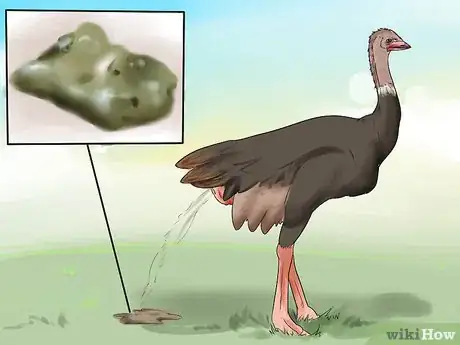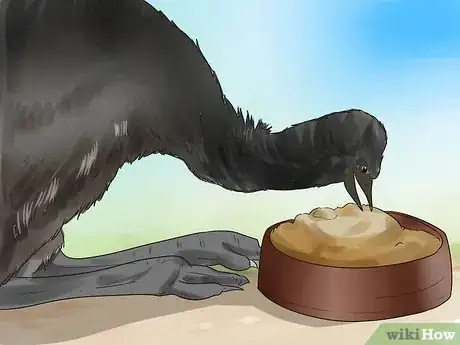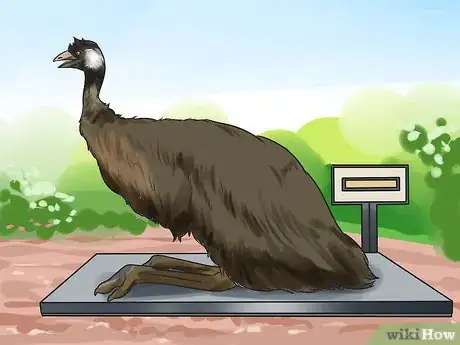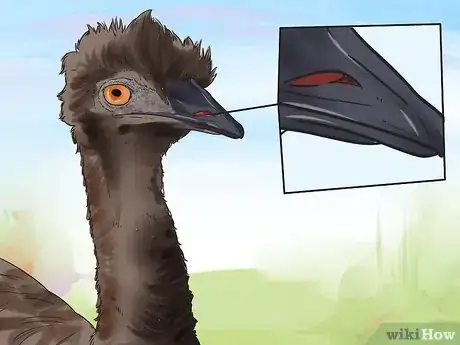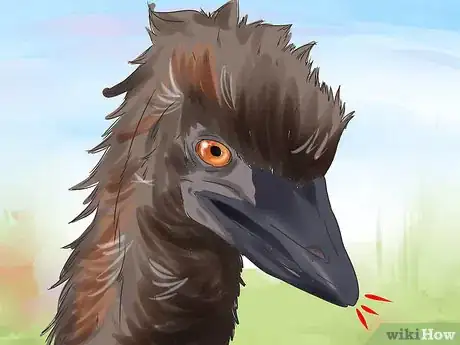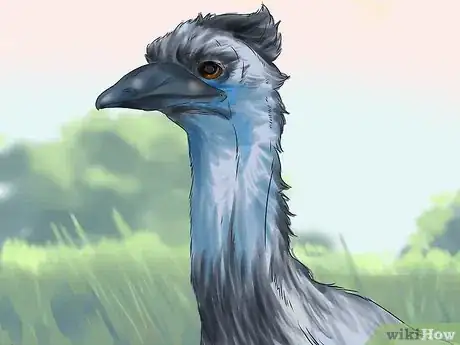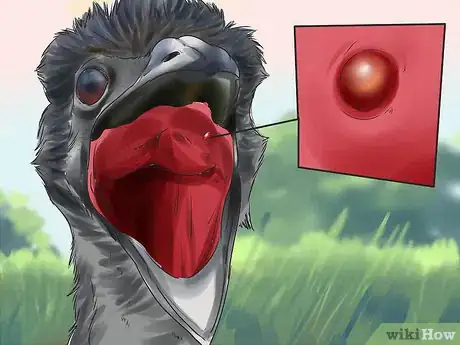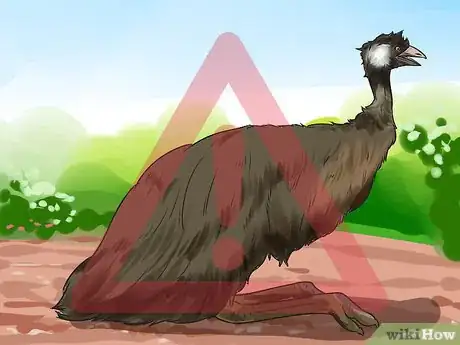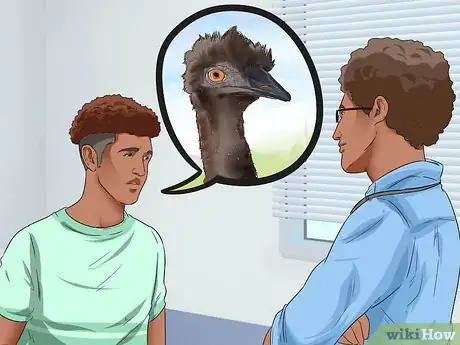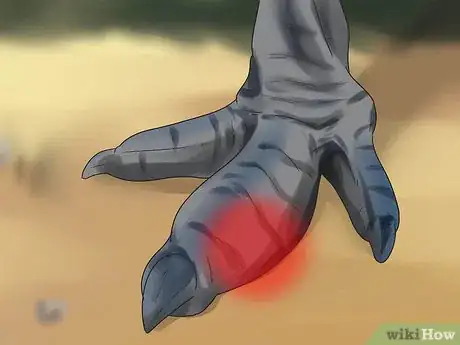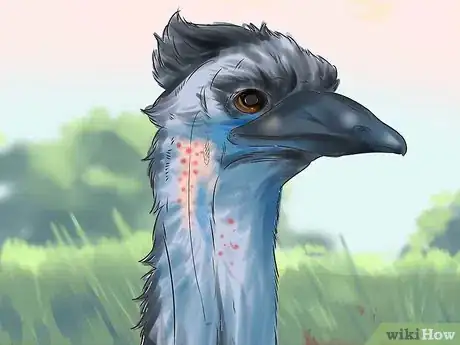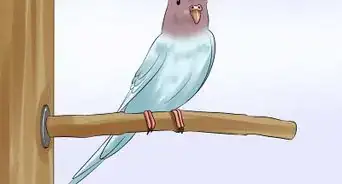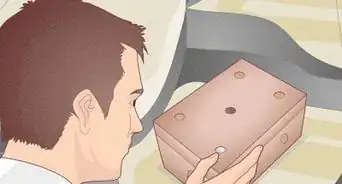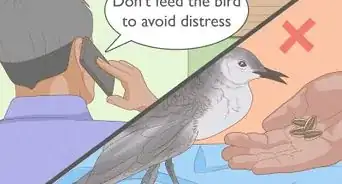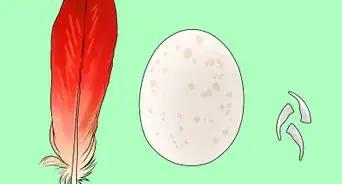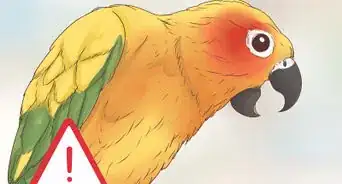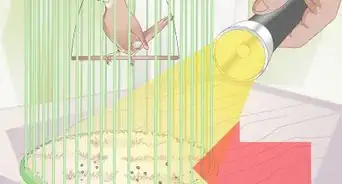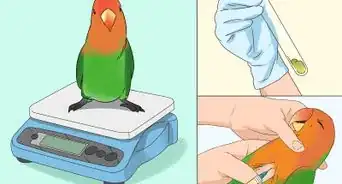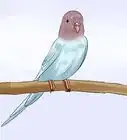This article was co-authored by wikiHow Staff. Our trained team of editors and researchers validate articles for accuracy and comprehensiveness. wikiHow's Content Management Team carefully monitors the work from our editorial staff to ensure that each article is backed by trusted research and meets our high quality standards.
This article has been viewed 37,770 times.
Learn more...
Emus belong to the Ratite family, along with ostriches. Emus are vulnerable to a variety of bird diseases, such as avian flu and encephalitis. If you are raising emus, it is important to know how to diagnosis illness in emus. By checking for gastro-intestinal symptoms, respiratory symptoms, and visible symptoms, you may be able to deduce what's wrong with your emu.
Steps
Looking for Gastro-intestinal Symptoms
-
1Check for diarrhea. Normal emu excrement is soft, but not runny or watery. Runny or water excrement, or diarrhea, is often a sign of disease in emu. While changes in diet will cause diarrhea, there are many diseases that may require treatment that also cause diarrhea. These include bacterial infections, avian influenza, fowl cholera, staphylococcus, as well as many other diseases that affect emu. You will need to see a vet or check for other symptoms to determine the cause of diarrhea.[1] [2]
-
2Check to see if your emu is eating well. Significant reduction in normal feed intake could be a symptom of Equine Encephalitis. Equine Encephalitis is a fatal disease for emus, so it is important to vaccinate them (though there are no FDA-approved vaccines specifically for emu.) Care needs to be taken when handling sick or dead emu so that the other birds don’t catch it. As it is passed through mosquito bites and can infect humans (though rarely), it’s a good idea to use insect repellant while working with emu, or in general, when outdoors in affected regions.[6]Advertisement
-
3Weigh your emu. Significant weight loss can be a symptom of fowl cholera, as well as a sign of tuberculosis. If this is the case, you should check with your vet.[7] Healthy weights in emu range from 90 to 150 pounds. You can use a platform scale and do scale training to get your emu to stay on the scale long enough to weigh them. Platform scales that can handle the weight of an emu can cost anywhere from just over a hundred dollars to over a thousand.[8]
- It might be a good idea to get a textured-surface scale so that your emu finds it easy to walk on it without slipping.
Looking for Respiratory Symptoms
-
1Look for discharge from nostrils or sneezing. Nostril discharge can be a symptom of Newcastle Disease (which can affect all types of birds), infectious bronchitis, avian influenza (Bird Flu), as well as several other diseases affecting emu. Sneezing can be the symptom of Newcastle disease, avian influenza, among other conditions, though not of infectious bronchitis. Again, the best course of action here is to see the vet or look for other symptoms to determine the disease.[9]
-
2See if the bird is coughing, gasping, or breathing abnormally. Coughing can be a symptom of fowl pox, Newcastle Disease, Avian Influenza, as well as many other conditions. Rales, the sound of abnormal breathing, is another thing to look out for in these conditions. In fact, rales accompanies most respiratory infections.[10]
-
3Check to see if they skin is bluish-purple. You can check this by parting the feathers. The skin on an emu's head is normally a mix of black, tan, blue, and white, and the rest of the skin is pinkish. Bluish-purple skin can indicate a lack of oxygen. This symptom appears frequently with Avian Influenza and Newcastle disease. Blue discoloration of the skin, or cyanosis, also occurs with Aspergillosis.[11]
- If you suspect a bird is sick, it is best to use gloves when examining it.
Looking for Surface Symptoms
-
1Look for lesions on the mouth. For outside lesions, they will be fairly obvious covering the beak area. This is a symptom of fowl pox, which can affect a large variety of poultry, including emu. If you find these, you need to quarantine the sick birds, as there is no treatment. Prevention is better, and can be maintained through mosquito control and vaccination, especially if fowl pox is common in an area. For lesions in the mouth, it is best to leave this to a qualified veterinarian.[12]
- In order to avoid damage from claws or beak, grasp the emu from behind at the wings. Then lift it up and back slightly. A hood can also be used to limit damage.[13]
-
2See how your emu’s stance is. If it is lying on the ground (known as prostration) or twisting its neck, it could have Newcastle Disease. In general, if the bird isn’t standing or moving about properly, you should check with a vet. Neck twisting also occurs with Aspergillosis.[14]
-
3Check for conjunctivitis. If the bird has conjunctivitis, it might have Newcastle Disease or Chlamydiosis, as well as a number of other conditions. See if it has other symptoms of one of these diseases to try to confirm a diagnosis. The best bet is to check with a vet.[15]
-
4See if there’s any swelling in the joints, footpads, wattle, or face. Swollen joints or footpads are often a symptom of staphylococcus or fowl cholera. A swollen face or wattle can be present in a number of conditions, so it is not evidence for a definitive diagnosis, but can aid you in knowing that something’s wrong with the emu. [16]
-
5Look for red or white spots on the wattle or comb. This is a common symptom of avian influenza that does not appear in some other conditions. So, it can be a telltale sign of avian influenza. As avian influenza is a rare threat to human health, it is important to contain it.
- You must report a suspected outbreak to the state veterinarian’s office.[17]
Community Q&A
-
QuestionHow do I obtain an Emu, and how hard is it to train it?
 Community AnswerCheck Facebook livestock groups, ask at local feed stores, go to small animal auctions and ask or post that you're looking for one. Even at 3 months old, which is the youngest you should get, there are many things you can teach your emu to do. They develop their own unique personalities as well.
Community AnswerCheck Facebook livestock groups, ask at local feed stores, go to small animal auctions and ask or post that you're looking for one. Even at 3 months old, which is the youngest you should get, there are many things you can teach your emu to do. They develop their own unique personalities as well. -
QuestionI have a 21-year-old emu. He has recently had what looks like a neurological problem. He will fall into the gate, and it's getting worse. He has actually fallen down, but no trauma occurred, and there were no wounds. He's had no new food/care. What is going on?
 LilyTop AnswererCall an animal care company ASAP, and tell them to come to you. Your emu may be developing something worse.
LilyTop AnswererCall an animal care company ASAP, and tell them to come to you. Your emu may be developing something worse. -
QuestionMy Emu is sick; she is not eating and is unstable standing. Her cheeks are swollen and she's having difficulty breathing.
 Community AnswerConsult your local vet or the national veterinary center.
Community AnswerConsult your local vet or the national veterinary center.
Warnings
- If your bird has a highly contagious disease, you may need to notify the state or federal government. The agency that takes the report may place your emu farm under quarantine and thoroughly disinfect it. In rare instances, this could include killing the entire flock to prevent bird diseases from spreading.⧼thumbs_response⧽
- The above does not constitute medical/veterinary advice, and is not meant to replace the advice of a qualified veterinarian.⧼thumbs_response⧽
- Many bird diseases, such as AI and END, are deadly. In fact, some ailments act so quickly that the bird expires without showing any symptoms at all.⧼thumbs_response⧽
- Some bird diseases spread easily. If you visit an infected emu farm, you could bring the illness back to your flock. Wear protective gear and practice sanitary emu husbandry.⧼thumbs_response⧽
- Bird flu can have a 100 percent mortality rate in 48 hours. Avian influenza comes in 2 forms: a weak type that could go unnoticed and an unusual variety that can kill the whole flock before you ever notice symptoms.⧼thumbs_response⧽
References
- ↑ https://www.merckvetmanual.com/exotic-and-laboratory-animals/ratites/infectious-diseases-of-ratites
- ↑ http://edis.ifas.ufl.edu/ps044
- ↑ https://www.merckvetmanual.com/exotic-and-laboratory-animals/ratites/infectious-diseases-of-ratites
- ↑ https://www.merckvetmanual.com/exotic-and-laboratory-animals/ratites/infectious-diseases-of-ratites
- ↑ http://edis.ifas.ufl.edu/ps044
- ↑ https://mcci.info/eee.aspx
- ↑ http://edis.ifas.ufl.edu/ps044
- ↑ https://www.valleyvet.com/ct_search_results.html?gas=scale
- ↑ http://edis.ifas.ufl.edu/ps044
- ↑ http://edis.ifas.ufl.edu/ps044
- ↑ http://edis.ifas.ufl.edu/ps044
- ↑ http://edis.ifas.ufl.edu/ps044
- ↑ https://www.merckvetmanual.com/exotic-and-laboratory-animals/ratites/management-of-ratites
- ↑ http://edis.ifas.ufl.edu/ps044
- ↑ http://edis.ifas.ufl.edu/ps044
- ↑ http://edis.ifas.ufl.edu/ps044
- ↑ http://edis.ifas.ufl.edu/ps044
